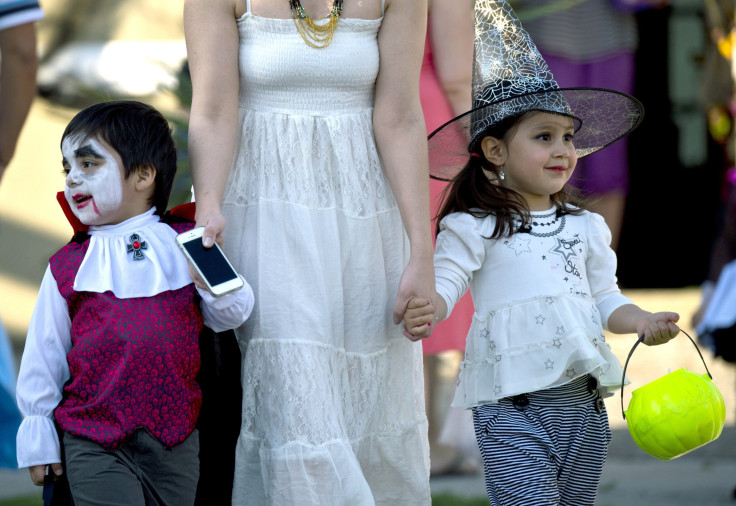Halloween 2015: 13 Trick-Or-Treat Safety Tips For Parents And Kids

The idea of a child running around at night asking strangers for candy might be a little anxiety-inducing for some parents. Halloween is fun for kids, but it can be overwhelming for worried adults. Luckily, there are several preventative measures that parents and guardians can take to make trick-or-treating as safe as possible.
Here's 13 trick-or-treating safety tips ahead of Halloween 2015:
1. Buddy System -- No one should ever be alone. Make sure kids know to stick together, especially if they’re old enough to go out without an adult.
2. Make An ID Tag -- No one plans to lose their little one, but it’s good to be prepared for the worst. The NYPD recommends attaching a tag with emergency contact info to the inside of costumes.
3. Flame Retardant -- Lots of people like to use real candles on Halloween, so make sure your little one’s costume can’t catch fire.
4. Flashlight -- Ideally, your streets are well-lit, but you never know when you’ll suddenly be in the dark. Make sure at least one person in your group has a working flashlight.
5. Cell Phone -- Most people don’t leave the house without it anyway, but make sure it’s fully charged. If your trick-or-treater is going without adults, make sure they have one just in case.
6. Find The Right Fit -- A long costume or a mask that’s too big could cause an accident. Cut the costume to the right length and/or cut bigger eye holes. Kids could also opt for face paint instead of masks, but the American Academy of Pediatrics warns against colored contacts. Without a prescription, the lenses may not fit and could lead to injury.
7. Reflective Tape -- If your kid refuses to have a brightly colored Halloween costume, attach reflective tape to their outfit to make them more visible to drivers.
8. Street Safety -- Remind your kids not to run, use crosswalks and stay on sidewalks. Even if they’ve been told a million times before, a reminder can’t hurt.
9. Make A Route -- Plan to go to areas you know and make sure you start walking back when the trick-or-treaters start getting a little tired. You don’t want to be a mile away from home when they decide that they’re ready for a nap.
10. Costume Allergies -- A few days before Halloween, test any face paint or makeup on their inner elbow for an allergic reaction. WebMD calls this the "patch test." If there is no reaction there, they probably won’t have an allergic reaction on their face.
11. Candy Allergies -- If your child is going with another parent, be sure to tell them if your trick-or-treater has a common allergy like peanut butter or chocolate. Similarly, if your child is very young, remind them of what they’re not allowed to eat.
12. Check Candy -- Don’t let children jump into the sugar rush without checking their candy. Make sure everything is sealed and unopened. If it’s opened or homemade, toss it. Mayo Clinic also recommends rationing out the candy so children don’t eat everything at once.
13. Talk To Your Kids -- Make sure you talk to them about trick-or-treating beforehand and go over these rules. If you need a little help, try showing this video with the “Power Rangers Dino Charge” cast to start the conversation.
Check out your local police department and town websites for more Halloween safety tips specific to your area.
© Copyright IBTimes 2025. All rights reserved.





















